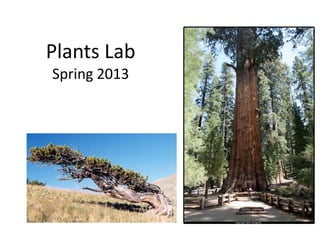
Plant Lab
- 4. Question • Newly-formed cells soon will differentiate into different types of cells and form tissues. Plant regions having undifferentiated cells are known as meristems. We find meristematic tissues at root tips. • Where else in a plant should you expect to find meristems?
- 5. Leaves
- 9. Question • Crystals in different plants occur as raphides (sharp needles), druses (star shaped) and other forms. Most are composed of calcium oxalate. • How might a plant benefit from having needles or other crystals in its leaves?
- 10. Lower Epidermis
- 11. Question • Another way plants protect themselves against excessive water loss is by secreting a waxy sort of substance to form a cuticle on the surface of a leaf. The cuticle is quite apparent in some leaf peels and cross sections • In which types of habitats do you think you’re most likely to find plants with significant cuticles?
- 13. Xylem and Phloem
- 14. Plasmolysis • Elodea leaves again!! • This time concentrate on chloroplast • Work in partners – One scope has water the other has salt water – Use the wet slide mount technique – Wait 15 minutes for salt water drawing • While we wait lets move to photosynthesis and respiration
- 15. Photosynthesis and Respiration • Recall from Window into a cell • Plants contain chloroplasts and mitochondria • While the chloroplasts are active during the day they are creating sugars in the form of glucose • When the mitochondria are active they use the glucose (sugar) to produce energy in the form of ATP
- 16. Question • Most living things require oxygen. – How can we breathe during the winter months in temperate zones? How do polar organisms manage? • Some people enjoy plants in a closed/sealed container called a terrarium. – How can the plants thrive with no access to the outside air?
- 17. Plasmolysis Before adding salt After adding salt
- 18. Why does this Happen? Osmosis • Osmosis example animation: – http://www.stolaf.edu/people/giannini/flashanim at/transport/osmosis.swf – In addition to the molecules and other structures, cells contain lots of water. Water is made of two hydrogen's and one oxygen molecule – Molecules are in constant motion. Molecules that are crowded into one area (higher concentration) will Spread out into an area of lower concentration
- 19. Elodea Osmosis Explanation • Plant cell in water: – Water molecules Enter the cell because the environment has higher concentration of water – Result = cell membrane is pushed outward by higher water pressure, giving the appearance to be spread out • Plant cell in salt water: – Water molecules Leave the cell to the environment because it has a lower concentration due to the salt – Result = cell membrane lacks water pressure and it appears to shrivel up
- 20. Starch and Plastids • Crackers • in finger bowl – What color are the following items when Iodine is applied (iodine reacts with starch it turns blue- black) • Potato • Been • Cornstarch • sugar
- 21. Starch and Plastids • Plastids are cells that store specific things – Chloroplasts is a plastid that stores chlorophyll – Amyloplasts are specific plastid and it stores starch grains
- 22. Amyloplasts
- 23. Reminders • Lecture: – Lecture Exam #1 Tuesday • Lab: – Quiz 5 – Take home quiz